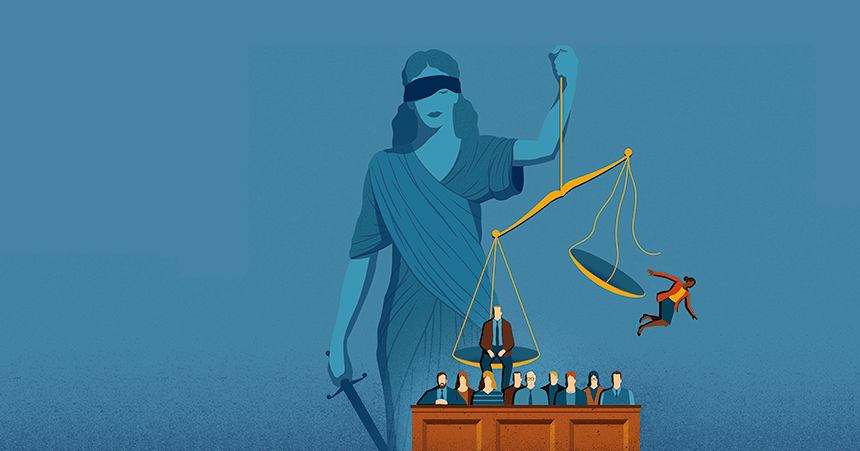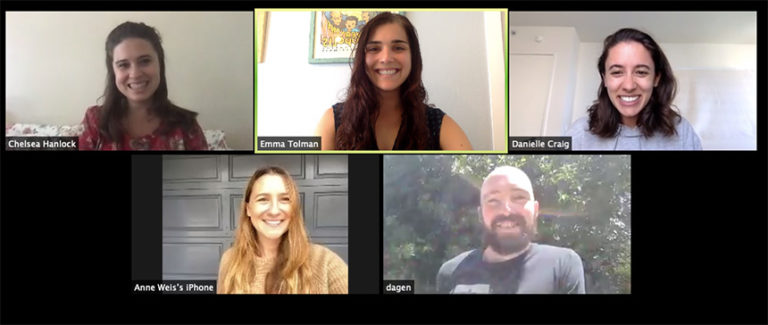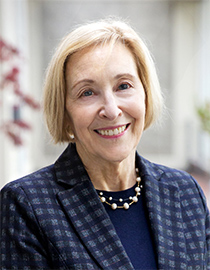Racial discrimination ingrained in jury selection, law school report finds

An eye-opening report from Berkeley Law’s Death Penalty Clinic finds that racial discrimination is a consistent aspect of jury selection in California. The exhaustive studyinvestigates the history, legacy, and ongoing practice of excluding people of color—especially African Americans—from state juries through prosecutors’ peremptory challenges.
Clinic students and faculty evaluated 683 California Courts of Appeal cases involving objections to these challenges, used by attorneys to excuse potential jurors without providing a reason why, from 2006 to 2018. Prosecutors used their strikes to remove African-American jurors in nearly 75 percent of these cases, Latinx jurors in about 28 percent, and white jurors in only three cases (0.4 percent).

Even so, the appellate courts found error in just 2.6 percent of those decisions. Over the last 30 years, the California Supreme Court has reviewed 142 cases involving such claims and found a violation only three times.
Professor Elisabeth Semel, director of the Death Penalty Clinic, authored the report with five of her students. She explains that the Washington Supreme Court’s adoption of General Rule 37 in 2018 propelled her to launch the study.
“The rule upends a 40-year-old procedure that has altogether failed to reduce, much less eliminate, the disproportionate exclusion of African-American and Latinx prospective jurors,” Semel says. “I was encouraged by the court’s leadership to believe that a careful and thorough investigation of the issue in California could produce meaningful reform.”
Clinic members hope Assembly Bill 3070, which they helped draft and is modeled on Washington’s rule, will create a new normal. Chelsea Hanlock ’20, who worked on the report with classmates Dagen Downard, Emma Tolman, Anne Weis, and Danielle Craig, says the bill is “essential to providing criminal defendants fair trials by a representative cross section of the community, and it’s essential in giving people of color access to civil society in ways long overdue.”
Downard played a major role in drafting AB 3070 (which the State Assembly approved by a 50-11 vote on June 11). It is sponsored by California Attorneys for Criminal Justice, which the clinic represents in advocating for passage. As the bill moves forward, Downard and other students are collaborating with Semel and a team of lawyers involved in the legislative process.
“From arrests to jury selection to sentencing, the criminal legal system has a deleterious effect on all of the lives it touches, disproportionately the lives of Black and Latinx people,” Downard says. “AB 3070 is one necessary step in eliminating racial discrimination in one part of the machine.”
How we got here
Unlike jury challenges for cause, each party in a trial may ordinarily excuse a set number of jurors without a stated reason or the court’s approval. In 1978, the California Supreme Court became the first state court to adopt a procedure to reduce the discriminatory use of peremptory challenges.
In 1986, the U.S. Supreme Court approved a similar approach in Batson v. Kentucky. A key aspect of that procedure, however, is that it only provides a remedy for intentional discrimination—which requires clearing a difficult three-step hurdle. An objection to a peremptory challenge on the ground that it was based on race, ethnicity, or another impermissible reason is known as a Batson motion.

“The California Supreme Court went from a judiciary that championed the eradication of race-based strikes to a court majority that resists even the U.S. Supreme Court’s limited efforts to enforce Batson,” Semel says. “Our report examines the shift in the state supreme court’s approach. There simply is no effective judicial impediment to prosecutors who routinely remove Black and Latinx citizens for purportedly race-neutral reasons that are plainly related to racial stereotypes.”
Craig wrote the section on implicit bias, highlighting its role in perpetuating discriminatory jury strikes, courts’ approval of those strikes, and how Batson’s requirement of proving intentional discrimination allows these biases to go unchecked. Empirical studies regularly showed that African Americans are over-associated with criminality.
Weis researched the different views that African Americans and whites hold about the criminal legal system and why these differences persist, examining social science studies conducted over the past 30-plus years.
“These studies consistently show that whites are more punitive than African Americans, believing that the criminal legal system operates in a race-neutral and generally fair manner,” she says. “On the other hand, based on history and lived experience, African Americans tend to be more distrustful of the criminal legal system and perceive the system to operate in a racially discriminatory manner.”
Craig notes that “African Americans suffer disproportionately higher arrests, higher likelihood of conviction on the same evidence than in cases against white defendants, and lengthier sentences than those imposed on white defendants under the same sentencing guidelines. The use of peremptory challenges in selecting juries is no exception to the racially discriminatory practices within the criminal legal system.”
Tolman reviewed hundreds of pages of powerpoint slides, manuals, and related items to determine how prosecutors are trained to avoid losing Batson motions.
“The materials encourage prosecutors to select jurors who resemble the typical prosecutor, a population that is overwhelmingly white, professional, and at least middle-income,” Tolman says. “Conversely, the materials also steer prosecutors away from selecting jurors who are low-income, had negative experiences with law enforcement, and are unemployed.”
Revealing research
Student research also demonstrates how training manuals consistently instruct prosecutors to rely on their “gut instincts” in selecting jurors, which the study shows is most likely to trigger implicit racial and ethnic biases.
And prosecutors are also trained to explain their strikes by referring to ready-made lists of reasons courts have found to be “race-neutral.” Semel says, “The training materials confirm how prescient Justice Thurgood Marshall was about Batson’s shortcomings, including the ease with which prosecutors would devise facially neutral reasons.”
Reasons for jury strikes included having dreadlocks, wearing a short skirt or large earrings, distrust of law enforcement, having family members who are incarcerated, and expressing a belief that the criminal legal system treats people differently based on their race.
To avoid insulating prosecutors from judges inquiring about potentially discriminatory strikes, the report urges eliminating Batson’s first step, which requires a prima facie (threshold)) showing of intentional discrimination. This change would also expedite the process of ruling on objections to such strikes. California Supreme Court Justice and former Berkeley Law professor Goodwin Liu has proposed this reform in dissenting opinions.
Consistent with Washington’s GR 37 and AB 3070, the report also proposes placing the burden of proof on the party exercising the challenge and presuming that specified reasons historically associated with improper discrimination are invalid. In line with the rule and the bill, the report recommends that the trial court explain its ruling on the record and decide the question as an objective observer who is aware of the role implicit and institutional bias plays in peremptory strikes.
Tolman also wrote the report’s section on Ninth Circuit Court of Appeals rulings in federal habeas Batson cases and the other on district attorney training manuals from 15 counties across California.
In some of the same cases in which the California Courts of Appeal and California Supreme Court found no Batson error, the Ninth Circuit more often took issue with the jury strikes. Between 1993 and 2019, the Ninth Circuit was over 10 times more likely to find error than the California Supreme Court.
“Because the circuit decides these cases under the rules applicable in federal habeas proceedings, the court applies a significantly higher standard than the state courts for finding error,” Tolman says. “I took this to mean California courts were unwilling to uphold Batson and its progeny, readily permitting the unlawful discrimination in jury selection.”
Despite the frustration in seeing how California courts have long enabled prosecutors to keep people of color off juries, the students describe the project as deeply gratifying.
“The most rewarding part has been working with and learning from brilliant people: our clinical supervisor, legislative advocates, public defenders, law students, a graphic designer, an editor, and clinical staff,” Downard says. “This has been one of the highlights of my law school career.”
